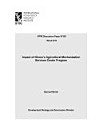Protected agriculture, precision agriculture, and vertical farming: Brief reviews of issues in the literature focusing on the developing region in Asia
Takeshima, Hiroyuki · Joshi, Pramod Kumar
březen 2019 · IFPRI Discussion Paper Kniha 1814 · Intl Food Policy Res Inst
3,0star
2 recenzereport
E‑kniha
49
Stránky
family_home
Vhodná
info
reportHodnocení a recenze nejsou ověřeny Další informace
Podrobnosti o e‑knize
The frontiers of technologies have been constantly expanded in many industries around the world, including the agricultural sector. Among many “frontier technologies” in agriculture, are protected agriculture, precision agriculture, and vertical farming, all of which depart substantially from many conventional agricultural production methods. It is not yet clear how these technologies can become adoptable in developing countries, including, for example, South Asian countries like India. This paper briefly reviews the issues associated withthese three types of frontier technologies. We do so by systematically checkingthe academic articleslisted in Google Scholar, which primarily focus on these technologies in developing countries in Asia. Where appropriate, a few widely-cited overview articles for each technology were also reviewed. The findings generally reveal where performances of these technologiescan be raised potentially, based on the general trends in the literature. Where evidence is rich, some generalizable economic insights about these technologies are provided. For protected agriculture, recent research has focusedsignificantly on various features of protective structures (tunnel heights, covering materials, shading structures, frames and sizes) indicating that there are potentials for adaptive research on such structures to raise the productivity of protected agriculture. The research on protected agriculture also focuses on types of climate parameters controlled, andenergy structures, among others. For precision agriculture, recent research has focused on the spatial variability of production environments, development of efficient and suitable data management systems, efficiency of various types of image analyses and optical sensing, efficiency of sensors and related technologies, designs of precision agriculture equipment, optimal inputs and service uses, and their spatial allocations, potentials of unmanned aerial vehicles (UAVs) and nano-technologies. For vertical farming, research has often highlighted the variations in technologies based on out-door / indoor systems, ways to improve plants’ access to light (natural or artificial), growing medium and nutrient / water supply, advanced features like electricity generation and integration of production space into an office / residential space, and water treatment. For India, issues listed above may be some of the key areas that the country can draw on from other more advanced countries in Asia, or can focus in its adaptive research to improve the relevance and applicability of these technologies to the country.
Hodnocení a recenze
3,0
2 recenze
O autorovi
Ohodnotit e‑knihu
Sdělte nám, co si myslíte.
Informace o čtení
Telefony a tablety
Nainstalujte si aplikaci Knihy Google Play pro Android a iPad/iPhone. Aplikace se automaticky synchronizuje s vaším účtem a umožní vám číst v režimu online nebo offline, ať jste kdekoliv.
Notebooky a počítače
Audioknihy zakoupené na Google Play můžete poslouchat pomocí webového prohlížeče v počítači.
Čtečky a další zařízení
Pokud chcete číst knihy ve čtečkách elektronických knih, jako např. Kobo, je třeba soubor stáhnout a přenést do zařízení. Při přenášení souborů do podporovaných čteček elektronických knih postupujte podle podrobných pokynů v centru nápovědy.










